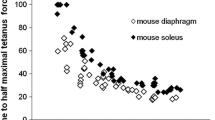Abstract
-
1.
Single fast fibres were isolated from the myotomal muscles of icefish (Chaenocephalus aceratus Lönnberg, Antarctica), North Sea Cod (Gadus morhua L.) and Pacific Blue Marlin (Makaira nigricans Wakiya, Hawaii). Fibres were chemically skinned with the non-ionic detergent Brij-58.
-
2.
Maximum tensions (Po, kN m−2) developed at the characteristic body temperature of each species are 231 for icefish (−1°C), 187 for cod (8°C) and 156 for marlin (20°C). At 0°CPo is 7 times higher for fibres from the icefish than from the marlin.
-
3.
Fibres from icefish and cod failed to relax completely following activations at temperatures above approximately 12°C. The resultant post-contraction force is associated with a proportional increase in stiffness, suggesting the formation of a population of Ca-insensitive cross bridges.
-
4.
At 0°C there is little interspecific variation in unloaded contraction velocity (V max) among the three species.V max (muscle lengths s−1) at normal body temperatures are 0.9 for icefish (−1°C), 1.0 for cod (8°C) and 3.4 for marlin (20°C).
-
5.
The force-velocity (P-V) relationship becomes progressively more curved with increasing temperature for all three species.
-
6.
Maximum power output for the fast muscle fibres from the Antarctic species at −1°C is around 60% of that of the tropical fish at 20°C. Evolutionary temperature compensation of muscle power output appears largely to involve differences in the ability of cross bridges to generate force.
Similar content being viewed by others
References
Altringham JD, Johnston IA (1982) The pCa-tension and forcevelocity characteristics of skinned fibres isolated from fish fast and slow muscles. J Physiol 333:421–449
Clarke A (1983) Life in cold water: the physiological ecology of polar marine ectotherms. Oceanogr Mar Biol Annu Rev 21:341–353
Connell JJ (1961) The relative stabilities of the skeletal muscle myosins of some animals. Biochem J 80:503–509
Fabiato A, Fabiato F (1979) Calculator programs for computing the composition of the solutions containing multiple metals and ligands used for experiments for skinned muscle cells. J Physiol Paris 75:463–505
Godt RE, Lindley BD (1982) Influence of temperature upon contractile activation and isometric force production in mechanically skinned muscle fibres of the frog. J Gen Physiol 80:279–297
Hill AV (1938) The heat of shortening and the dynamic constants of muscle. Proc Roy Soc London B 126:136–195
Huxley AF, Simmons RM (1971) Proposed mechanism of force generation in striated muscle. Nature 233:533–538
Johnston IA (1982) Biochemistry of fish myosins and contractile properties of fish skeletal muscle. J Mol Physiol 2:15–29
Johnston IA (1985a) Temperature adaptation of enzyme function in fish muscle. In: Laverack MS (ed) Symp Soc Biol. University Press, Cambridge (in press)
Johnston IA (1985b) Effects of temperature on force-velocity relationship of skinned fibres isolated from Icefish (Chaenocephalus aceratus) skeletal muscle. J Physiol 361:40P
Johnston IA, Brill R (1984) Thermal dependence of contractile properties of single skinned muscle fibres isolated from Antarctic and various Pacific marine fishes, including skipjack tuna and kawakawa. J Comp Physiol B 155:63–70
Johnston IA, Gleeson TT (1984) Thermal dependence of contractile properties of red and white fibres isolated from the iliofibularis muscle of the desert iguana. J Exp Biol 113:123–132
Johnston IA, Harrison P (1985) Contractile and metabolic characteristics of muscle fibres from Antarctic fish. J Exp Biol (in press)
Johnston IA, Salamonski J (1984) Power output and force-velocity relationship of red and white muscle fibres from the Pacific Blue Marlin. J Exp Biol 111:171–177
Johnston IA, Sidell BD (1984) Differences in temperature dependence of muscle contractile properties an myofibrillar ATPase activity in a cold-temperate fish. J Exp Biol 111:179–189
Johnston IA, Walesby NJ, Davison W, Goldspink G (1975) Temperature adaptation in myosin of Antarctic fish. Nature 254:74–75
Kuhn HJ, Guth K, Drexler B, Berberich W, Ruegg JC (1979) Investigation of the temperature dependence of the cross bridge parameters for attachment, force generation and attachment as deduced from mechano-chemical studies in glycerinated single fibres from the dorsal longitudinal muscle ofLethocerus maximus. Biophys Struct Mech 6:1–29
Lannergren J (1978) The force-velocity relation of isolated twitch and slow muscle fibres ofXenopus laevis. J Physiol 283:501–521
Putnam RW, Bennett AF (1982) Thermal dependence of isometric contractile properties of lizard muscle. J Comp Physiol B 147:11–20
Ranatunga KW (1982) Temperature dependence of shortening velocity and rate of isometric tension development in rat skeletal muscle. J Physiol 329:465–483
Reeves RB (1977) The interaction of body temperature and acid-base balance in ectotherms. Am Rev Physiol 39:559–586
Stephenson DG, Williams DA (1981) Calcium-activated force responses in fast- and slow-twitch muscle fibres of the rat at different temperatures. J Physiol 317:281–302
Author information
Authors and Affiliations
Rights and permissions
About this article
Cite this article
Johnston, I.A., Altringham, J.D. Evolutionary adaptation of muscle power output to environmental temperature: force-velocity characteristics of skinned fibres isolated from antarctic, temperate and tropical marine fish. Pflugers Arch. 405, 136–140 (1985). https://doi.org/10.1007/BF00584534
Received:
Accepted:
Issue Date:
DOI: https://doi.org/10.1007/BF00584534




